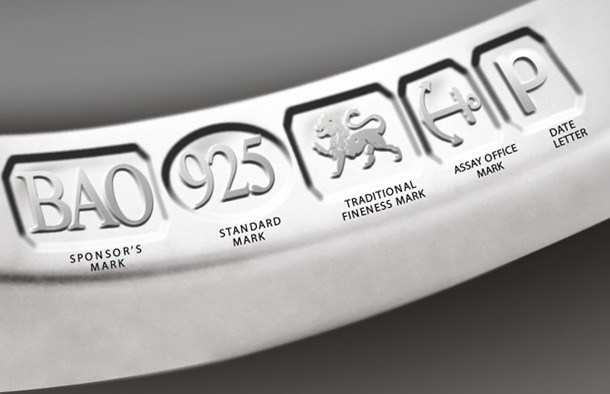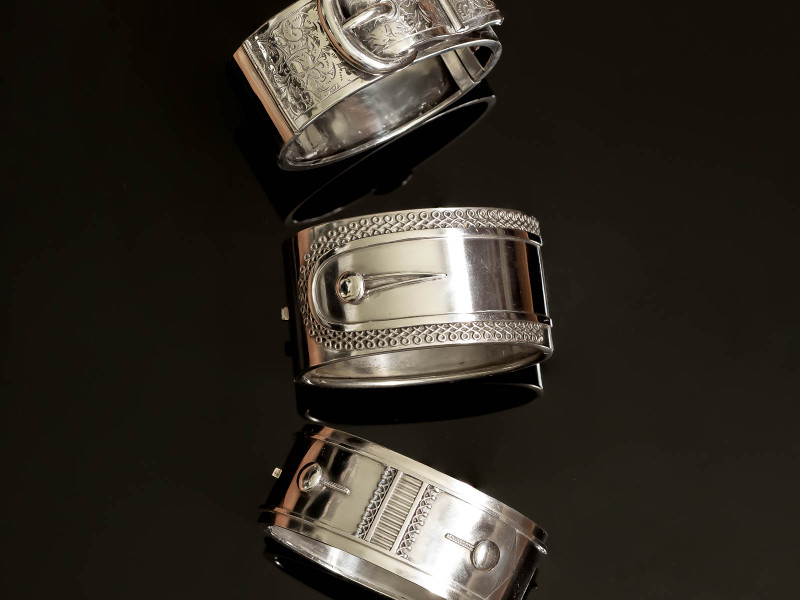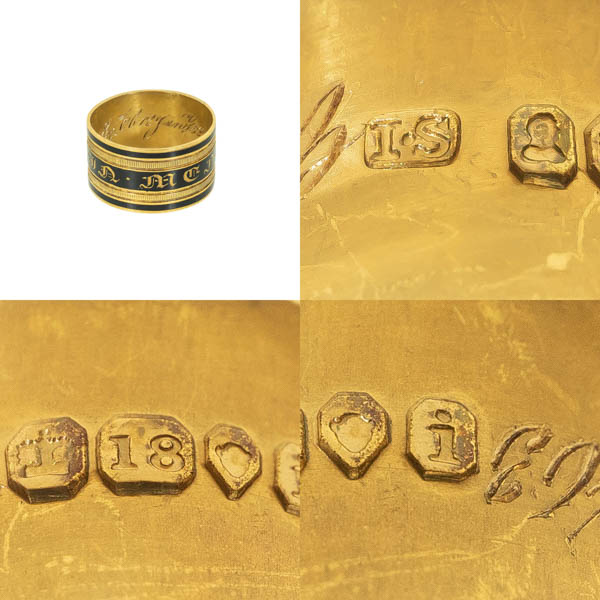WHAT IS A HALLMARK?
Did you recently purchase your first piece of antique jewelry? Would you like to know what the hallmarks stamped on your jewelry mean? We’re here to help!
There are a number of methods that are used to evaluate the age of a piece of jewelry, but in this post we’ll focus on English and French vintage and antique jewelry. And while most of this post is aimed at those new to the hallmarking system, I will guarantee that there will be at least one nugget of information that will be news to a number of collectors and perhaps even a dealer or two, read on to find out.
In England, Hallmarks identify (and guarantee) the type of precious metal, the fineness or purity of that metal, which office assayed the piece, and the date it was assayed. Today a hallmark is a legal requirement in the U.K. If an article contains precious metals and is described as such, it must be hallmarked.
Historically, for a variety of reasons the French system is a bit more convoluted.
There are plenty of genuine antique pieces of jewelry that do not have hallmarks. Not every piece was hallmarked. It does not mean it is a fake, it just means that you have to rely on other methods to evaluate the period in which it was made.
In this post, Part I of “Interpreting Hallmarks on Jewelry,” we’ll take a look at the English system. In Part II, we'll take a look at the French system.
WHEN DID HALLMARKING BEGIN?
Hallmarking in England dates back to 1300 when King Edward I passed legislation to prevent fraud by goldsmiths. Silver had to be .925 (the same as the standard for Sterling Silver today) and at that time, gold was required to be 19.2 carats. (Source: Assay Office, London)
As the years passed, the standards required for gold purity changed and various Assay Offices were established. Some opened and closed more than once over their long history. See the list of Assay Offices and their dates below.
THE ANATOMY OF A HALLMARK: THE BASICS
This first image is from the U.K. Assay Office. It reflects current standards, but it is still a useful reference image for vintage and antique jewelry.

Assay Office, Birmingham
Below is a real world example. This image from our shop shows the hallmarks that have been struck on an antique gold mourning ring. Not every set of hallmarks looks this way. But it is helpful to walk through an example. So let’s identify the marks from left to right.
The first mark "IS" is the maker's mark. Sometimes a piece will have the registered mark of the maker, usually in the form of initials set within a lozenge or a rectangle. With some research, sometimes it is possible to find out who made the piece. The second mark is the duty mark (seen less frequently). The third mark is a crown indicating the object is gold.
The last three marks on this ring are the ones to focus on: the purity mark (the 18 in the rectangle with clipped corners), the city mark (the leopard's head in the diamond shaped cartouche), and the date (the box with the "i"). These are the ones you will see most frequently.
A note on the metal mark: I am so familiar with what they look like, that they are almost invisible to me. But if this is new to you, visit the sites mentioned below to get to know the marks for sterling silver (the Lion Passant) and for gold (a crown). There are also marks for silver plate and platinum, but they are not covered in this post.
THE PURITY MARK
The ring above is from the Georgian period, more specifically George IV: 1820-1830. The ring is available for purchase in our boutique Sugar et Cie. It is 18ct, 750 parts gold per 1000 or 75% gold and 25% alloy metal. The 18ct gold is represented by the 18 seen in the hallmarks above.
Here are the fineness marks for the different purities of gold.
22 = 91.6% or 22ct gold
18 = 75.0% or 18ct gold, “750”
15 = 62.5% or 15ct gold
14 = 58.5% or 14ct gold
9 = 37.5% or 9ct gold, “375”
925 = 92.5% or Sterling Silver
THE CITY MARK
The second mark is the town/city mark, where the piece was assayed (tested and marked). This one is marked with the Leopard head (following) the 18. The Leopard Head in this set of hallmarks represents the London Office.
Some of the offices you will come to know, some are more obscure, and some have changed over time. Always start with the city mark. Historically, each Assay Office (City Mark) had its own date chart. So the easiest way to look up the date is to identify the city/office first and then look for the letter (date) on that city’s reference sheet.
LOOKING UP THE DATE - WHEN WAS IT MADE?
A date mark is a good approximation for when a piece was made. Although, it is possible it could have been made in one year and hallmarked in the following year. The reference I like to use (and the easiest to navigate) when looking up a date mark is an online site called: British Sterling.
This is where a sharp eye and experience comes in. Sometimes it can be challenging to identify the correct letter/year.
Believe it or not, one letter for example, a "J" from one year can look like an "L" from another.
You need to look for a match to the shape of the letter. Sometimes it is obvious, and other times it is not quite as clear. Don't focus on the background shape/cartouche (read on for more on this lesser known tidbit). After I have identified the year/letter or at least or narrowed down the possibilities, I take a second look at my printout of the date charts directly from the Assay Office, Birmingham. They have historical date charts by City. I use my loupe to study both the mark itself, and the version on the printed date chart.
If you are hunting for antiques in the field and are concerned you may not have WiFi or a cellular connection, you can take your printout or purchase a pocket guide on Amazon.
We know this is London. So we look up the date charts for London and search for the “i” that matches. This particular “i” represents the year 1824. And of course, we have a number of things that help us corroborate. The style of the ring, the inscription on the inside: Geo (George) Ranking Ob 12 Jan 1825.
OTHER MARKS YOU MAY SEE
You may also occasionally see other marks.
Commemorative marks: (20th c.) to celebrate an event e.g. Silver Jubilee.
Duty Marks: The Sovereign’s Head indicated that Duty had been paid on an item. They were used from December 2, 1784 to April 30, 1890. During this period a variable tax was levied on all silver and gold assayed in Great Britain. Duty marks are less common. Keep in mind the mark or symbol did not always change with the change of a Monarch.
A law was passed in 1842 to make it illegal to sell imported gold or silver in the UK unless it was assayed (tested) at a British office. However, the Foreign Mark was not added until 1867.
MORE ABOUT DATE MARKS - HERE'S A LESSER KNOWN FACT!
Here's an interesting fact about dating your piece of antique jewelry (or anything with an antique British Hallmark). The cartouche or background for the date letter are pertinent for silver. When it comes to looking up the hallmarks on gold, the most important thing to match is the letter (as mentioned) and the style of the letter. Is it capitalized or lower case? Look at every little curve and angle. Here's what the Assay Office says "It is the letter font that will give you the correct date not the outline design." This may seem like a small detail, but I am guessing that it has led a number of people astray.
MYTH OR FACT
Myth or Fact? (1): Everything in the 18th and 19th centuries was hallmarked. If it doesn't have a hallmark, it's a fake or a reproduction.
This is a MYTH. Many pieces from this period were not hallmarked. However, if it is not hallmarked you either need to develop the skills to assess the piece on your own or ask an expert. An expert will look at the style, the materials used, the gemstones, the findings, and a variety of other factors to date it. Hallmarking gives you a bit more certainty (although even hallmarks can be faked). It helps you date it within a year (or two) rather than a broader range of time (circa).
Myth or Fact? (2): Date Letters ran consecutively and repeated every 26 years.
This is part MYTH and part FACT. Yes, they do run alphabetically and consecutively. However, the font can make it possible to confuse certain letters. Because of this, it is possible that the letter I, J or L is skipped. As a result, the date letter cycle is usually 25 as opposed to 26 years.
While it’s not possible to cover every facet of the history of English hallmarking in one blog post, I hope this helps you with the basics. With a little research and practice, you’ll be able to begin to identify the dates on the pieces of English antique jewelry you come across.
HERE IS A LIST OF ASSAY OFFICES
This is a complete list of Assay Offices.
U.K.
Birmingham Assay Office
Edinburgh Assay Office
London Assay Office
Sheffield Assay Office
Ireland
Dublin
Assay Offices Now Closed
Chester: 15th c. Opened 1700 - closed 1962
Exeter: Mid 16th c. Opened 1701 - closed 1883
Glasgow: Closed March 31, 1964
Newcastle: 17th c. - closed 1884
Norwich: Mid 16th c. - closed 1702. Note: The town marked changed over time.
York: Opened in the middle of the 16th c. closed in 1700, reopened 1701, closed in 1714 and closed permanently in 1858. The town mark for this location changed and evolved over time.


